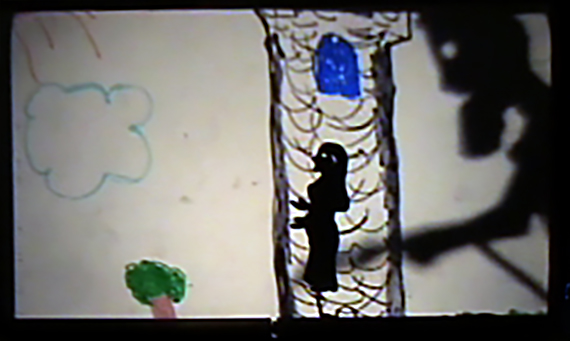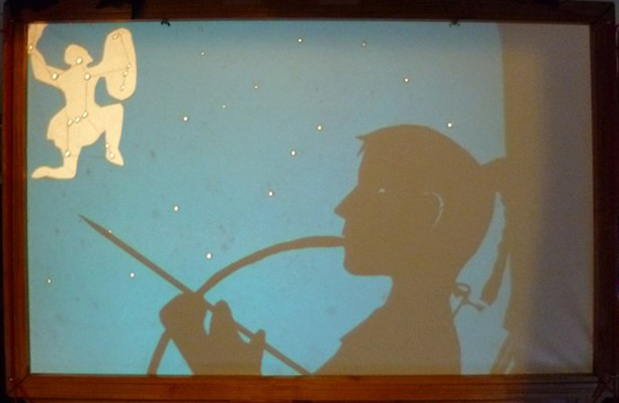If you are doing a shadow puppetry performance for larger audiences, using an overhead projector as the light source has several advantages. The light is stronger than traditional lamps and is distributed more evenly over the screen. Using transparent film on the projector makes the performance also more visually appealing, and allows for tricks that are particularly useful for myths and ancient stories from world religions. Children can let Moses part the Red Sea, make water rise in a Native American flood myth, let Jesus walk on the water, and have lotus flowers sprout in Siddhartha’s footsteps. In this post a few examples of the use of an overhead projector applied to Greek myths.
- Using a big screen
- Going bigger: using masks and direct projection
- Teaching Greek mythology with shadow puppets
Celestial beings descending to earth
One way to indicate the difference between a deity and mortal person is by size. In this example 4th graders acted out the story of Zeus falling in love with Danae, who was locked in a tower, drawn on a transparency sheet on the overhead projector. By putting the top part of the puppet of Zeus on the overhead projector, then slowly moving him to Danae on the screen while staying in the beam of light, children imitated Zeus descending to earth.

Using objects on a screen
You can create the effect of a boulder rolling uphill by folding a pyramid out of cardboard or card stock paper and putting it the overhead projector. Make a boulder by cutting a piece of sponge in the right shape and attach it to a piece of thread. Put the boulder at the bottom of the cardboard hill on the projector and pull it up while the student behind the screen pretends to push the boulder up the hill.
Sisyphus pushing a boulder uphill (sponge and cardboard on projector)
Using transparencies
In this story of the goddess Artemis and the hunter Orion, Orion is shown as a constellation in the sky after his death. The effect is created by using a blue transparent divider from an office supply store on the projector, attached to an additional clear transparency. The shape of Orion is cut out from the blue transparency while holes are punched for the stars. In this photo, the puppet of Artemis is also put on the projector.

Constellations
Overhead projectors are great for acting out any constellation myth. In this 4th grade performance children drew a picture of Pegasus on a transparency, based on online image research. The transparency on the overhead projector was slowly replaced by a sheet of black paper, in which the stars of the constellation were punched out.

Using a rolling rack
To create the illusion of moving, you can build a rolling rack following the instructions provided by David and Donna Wisniewski in Worlds of Shadow, Teaching with Shadow Puppetry. The background is drawn with permanent markers on transparent film. In this footage Charon is rowing Orpheus, who is playing the lyre, across the river Styx to the Underworld. To increase engagement with the children, the boat and puppets were attached to the front of the screen while children handle the moving rods.
Charon rowing Orpheus (playing the lyre) to the Underworld across the river Styx


Do you have a recommendation for how to purchase an OHP that’s good enough for doing shadow puppetry?
Hello! I bought my overhead projectors second hand from eBay more than 15 years ago so it has been a while. They were the kind of projectors used in classrooms and libraries for presentations with transparencies. They take Eiko Enx 82V 360W projector bulbs, which are still available and fit into projectors in the first category of this chart that I found https://www.usi-laminate.com/pages/90/overhead-projector-comparison-chart . The light is quite sufficient as long as you keep the room dark. The chart may guide you further, the brighter the light, the sharper the shadows. I would go for a surface that has a minimum of 11″ wide, so that you can put a standard size transparency on it. You will have to tape off part to project a rectangle screen.
I have an overhead projector and now I need a screen. The first story I want to tell will have involve several figures. I need advice on the size and how to make a screen.
I wonder also if you do virtual workshops or one-on-one instruction.
Hello Arlene, thanks for reaching out!
In the post Using a Big Screen you see a 56″x36″ traveling screen made of 1 5/8″ canvas stretcher strips (available in art stores). For the screen I used Twin White Rosco Screen, which you can nail into the frame. My friend Tore in Sweden used sail (used in sailboats), which is a bit stiffer but looks even better.
For support I use second-hand Ikea floor lamp poles and attach the screen with Velcro (when I performed with children I used weight discs to make them less likely to fall over). In my post How to make a portable shadow screen for classrooms you find these poles in the instructions.
In that post you see that I can fit five puppets that are about 10″ tall on that screen. (Their holding rods are attached with velcro to a velcro strip underneath the screen). Mind you, even if you “park” your puppets, you can only move one or two puppets at the same time if you are doing it alone.
A screen and 10″ puppets are good enough for an audience in a room, but if you are going bigger you’ll need puppets that are more around 13-15″ tall. That is the size of the puppets that are used by the 4th graders in a performance of the Perseus myths depicted here. It is also the size of the puppets that you see in this blog post about using an overhead projector.
For the screen I used Twin White Rosco that I sewed to a piece of cloth behind which the children could sit and kneel, holding the puppets. The top was attached to a round pole with screw eyes on each side, so that I could roll it up for storage. For the supports I used much wider torchiere floor lamp post that were very cheap at the time. I took the lamps off so that the metal threading remained, which I used to hook the screw eyes over.
In the screen with Charon on his boat on the river Styx that you see above, I used thicker canvas stretchers than described earlier, with the bottom one screwed onto a square pole attached to a wide plank, which you can secure to a table with C-clamps. For a more traditional screen with a wooden frame to use with an overhead projector you can find detailed instructions in the book World of Shadow by David and Donna Wisniewski.
I am in the process of moving house, but after the summer I am planning to offer online workshops and instruction. Meanwhile I hope that this is helpful!
Helene